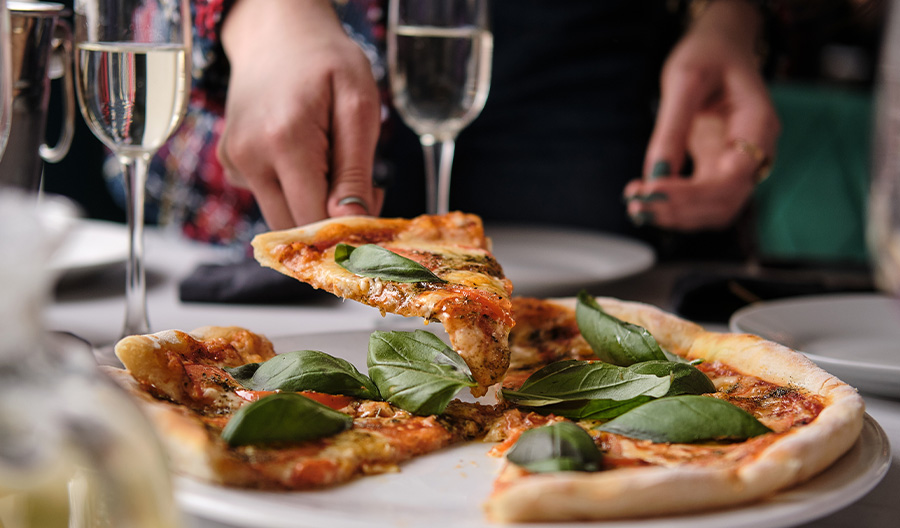Champagne famously goes with just about any dish thanks to its food-friendly acidity and carbonation. But how does it work as a pizza ingredient?
An Italian restaurant group based in New York City with a handful of outposts around the world, is testing out the idea with its new Champagne Pizza. As of Monday, customers can order the limited-edition menu item, which includes Champagne in the dough and is topped with mozzarella and cacio e pepe sauce. The Champagne-infused dish sells for $29.
I was intrigued by the concept, not only because of a primal reaction to seeing the words “Champagne Pizza” in my inbox, but also the theory behind the dish. It makes sense that Champagne would work in a pizza dough since it retains natural yeasty qualities from the wine-making process.
So, at a preview lunch held at the restaurant's new Union Square location, I tried two wood-fired pies made with the Champagne dough: the new cacio e pepe flavor and the popular tartufo nero (black truffle). The owners said they simply replaced the water in the usual pizza dough recipe with an equal amount of Champagne, which cooks off during the baking process.
How did these pies fold up? (Sorry.) The texture of the thin-style crust was nice and crispy. Flavor-wise, both were delicious, especially the cacio e pepe, which basically tasted like adult mac and cheese. That said, there wasn’t a perceptible Champagne flavor to the crust itself. Any prominent Champagne notes were likely cooked off during the baking process, and what remained tasted like…well, pizza crust, which is to say yeasty and ever so slightly sweet. That’s arguably a good thing for pizza purists, but it also bears questioning: Is this dough worth the dough?
If you find yourself at on of the retaurant's branches, the $29 pie is comparable to other pizzas on the menu, which range in price from $23–31. And as theowners noted, it’s a nice and inclusive idea for graduations or other celebratory occasions where not everyone is imbibing. But should Champagne be your new secret ingredient for homemade pies?

I asked Daniel Gritzer, senior culinary director of our sibling brand Serious Eats, about the potential for Champagne in pizza dough. While receptive to the idea, he was skeptical.
“Adding carbonated liquids to batters and doughs is not unheard of and can sometimes be beneficial. The carbonation creates bubbles, which can lead to airier results. And without a doubt, any ingredient like Champagne, which has flavor all its own, can pass that flavor on to the dough,” says Gritzer.
“But—and it’s a big but—pouring pricey Champagne into a pizza dough sounds a lot more like a marketing stunt than a baking best practice. There are far more economical ways of making top-notch pizza dough...namely, working with high-quality basic ingredients and skillfully using yeast, time, and technique to make great dough.”
“I’d save the bubbly for the wine glass,” he adds.
If you do want to experiment with sparkling wine in your cooking at home, it may be worth starting with something more affordable, like prosecco. However, with pizza in particular, the combination of flavors will probably overpower any of the wine’s remaining profile, especially when you factor in toppings like tomato sauce and cheese, notes Gritzer.
“So many flavors are generated naturally through a slow dough fermentation, including many of those yeasty qualities that one gets in a wine like Champagne, that I’m really doubtful the wine is going to do much at all,” he says.
Serving Champagne with pizza, though? That’s always a great idea.

